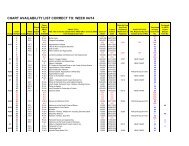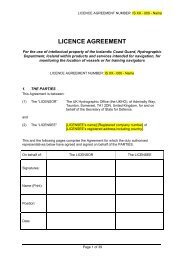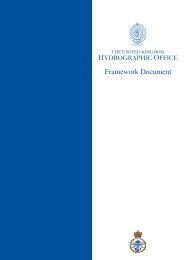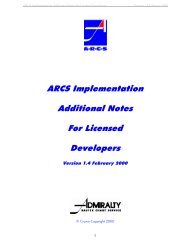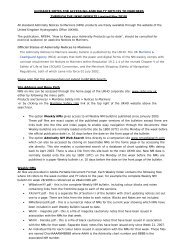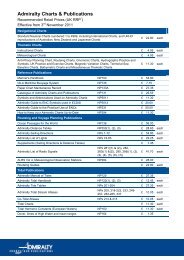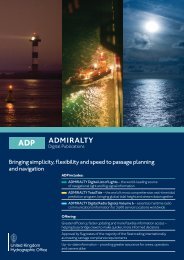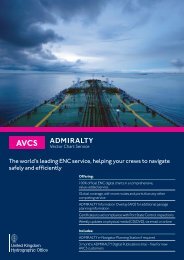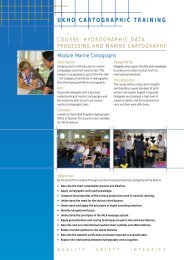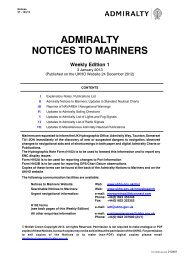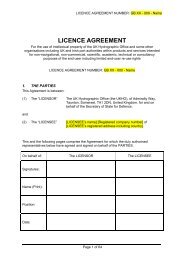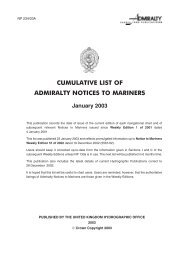UK National Report - 2009.pdf - United Kingdom Hydrographic Office
UK National Report - 2009.pdf - United Kingdom Hydrographic Office
UK National Report - 2009.pdf - United Kingdom Hydrographic Office
Create successful ePaper yourself
Turn your PDF publications into a flip-book with our unique Google optimized e-Paper software.
UNITED KINGDOM<br />
GENERIC NATIONAL REPORT<br />
TO<br />
REGIONAL HYDROGRAPHIC COMMISSIONS<br />
2009<br />
NOTE: This report provides general information about the <strong>United</strong> <strong>Kingdom</strong> <strong>Hydrographic</strong> <strong>Office</strong> and its<br />
activities of interest to Regional <strong>Hydrographic</strong> Commissions and to other IHO Member States; the<br />
report will be revised annually. A supplementary <strong>UK</strong> <strong>National</strong> <strong>Report</strong> will be submitted to each Regional<br />
<strong>Hydrographic</strong> Commission attended by <strong>UK</strong>, to provide the information specifically relevant to that<br />
Commission. For further details of <strong>UK</strong>HO’s role and other activities, see the <strong>UK</strong>HO website<br />
(www.ukho.gov.uk).<br />
www.ukho.gov.uk
Page intentionally left blank<br />
Page 2 of 14
1. UNITED KINGDOM HYDROGRAPHIC OFFICE (<strong>UK</strong>HO)<br />
<strong>UK</strong> Delivery of <strong>Hydrographic</strong> Services<br />
1.1 <strong>UK</strong> is a Contracting Government to the International Convention for the Safety of Life at Sea<br />
(as amended and including its Protocol of 1988), 1974 (SOLAS). The <strong>UK</strong> Maritime and Coastguard<br />
Agency (MCA), an agency of the Department for Transport, is the <strong>UK</strong> <strong>National</strong> Maritime<br />
Administration, and is responsible for ensuring that <strong>UK</strong>’s obligations under SOLAS are met.<br />
1.2 The <strong>UK</strong>HO cooperates closely with MCA to ensure both appropriate provision of<br />
hydrographic services for waters of <strong>UK</strong> national responsibility, and representation of <strong>UK</strong> in<br />
international hydrographic and maritime fora. Further details of the delivery of hydrographic services<br />
in <strong>UK</strong> waters are provided in International <strong>Hydrographic</strong> <strong>Office</strong> (IHO) publication M-16 (<strong>National</strong><br />
<strong>Hydrographic</strong> Regulations).<br />
Secretary<br />
of State for<br />
Defence<br />
Secretary<br />
of State for<br />
Transport<br />
Minister Minister Under Secretary of<br />
of State for of State for State for Defence<br />
Defence Equipment Armed Forces and Veterans Minister<br />
Chief of<br />
Defence<br />
Intelligence<br />
Commander<br />
in Chief Fleet<br />
Director General<br />
Intelligence<br />
Collection<br />
MCA<br />
Chief Executive<br />
Peter Cardy<br />
Defence Programme<br />
<strong>UK</strong>HO<br />
Chief Executive<br />
Mike Robinson<br />
<strong>National</strong> Programme<br />
1.3 In addition to meeting SOLAS obligations, <strong>UK</strong>HO has a responsibility to deliver hydrographic<br />
support to the <strong>UK</strong> armed forces for operations world-wide, and contributes to <strong>UK</strong>’s efforts to provide<br />
technical assistance to other countries.<br />
<strong>UK</strong>HO Governance<br />
1.4 The <strong>UK</strong>HO is a Trading Fund agency of the Ministry of Defence (MOD). As a Trading Fund,<br />
the <strong>UK</strong>HO is required to be self financing. It retains the income it receives for its products and<br />
services to cover running costs and to fund investment. It pays a dividend to its parent department,<br />
the MOD, and is required to make a small return (currently 9%) on the capital employed. The status<br />
of all Government Agencies, including <strong>UK</strong>HO, is subject to regular Government scrutiny; the most<br />
recent of which, as reported in our 2008 Generic <strong>National</strong> <strong>Report</strong>, confirmed the current status to be<br />
that appropriate for such an organization with an international remit. The MOD’s expectations of the<br />
<strong>UK</strong>HO are contained in the Framework Document which is available from the <strong>UK</strong>HO website:<br />
http://www.ukho.gov.uk/AboutUs/Pages/Corporate.aspx<br />
Page 3 of 14
1.5 <strong>UK</strong>HO’s current top level organization structure is:<br />
<strong>Hydrographic</strong> <strong>Office</strong><br />
Owner’s Council<br />
<strong>Hydrographic</strong><br />
<strong>Office</strong> Board<br />
Chief Operating <strong>Office</strong>r and<br />
Deputy Chief Executive (Corporate)<br />
Michael Cauter<br />
Chief Executive<br />
Mike Robinson<br />
<strong>National</strong> Hydrographer and<br />
Deputy Chief Executive (Hydrography)<br />
Rear Admiral Ian Moncrieff<br />
Finance and Business<br />
Infrastructure<br />
Transformation, Change<br />
and Human Resources<br />
Operations<br />
Admiralty Nautical<br />
Products and Services<br />
Information<br />
Management and<br />
Technology<br />
<strong>National</strong> Hydrographer<br />
and Defence<br />
1.6 The owner of the <strong>UK</strong>HO is the Secretary of State for Defence. He delegates responsibility<br />
for the <strong>UK</strong>HO to the Parliamentary Under Secretary of State for Defence and Minister for Veterans<br />
(USofS). Mike Robinson, as Chief Executive of the <strong>UK</strong>HO, reports to USofS. The <strong>UK</strong>HO Corporate<br />
Plan is approved by USofS and he receives regular performance reports. USofS is advised by the<br />
<strong>Hydrographic</strong> <strong>Office</strong> Owner’s Council, which is composed of representatives from government, such<br />
as the MOD and the MCA, and the shipping industry.<br />
1.7 The <strong>Hydrographic</strong> <strong>Office</strong> Board (HOB) meets monthly to provide strategic guidance and to<br />
ensure that the Corporate Plan is achieved. The HOB has a non executive Chairman, David Palmer<br />
CBE; and includes: the Hydrographer of the Navy; a Trades Union representative; 3 non-<br />
Executives; plus the <strong>UK</strong>HO Chief Executive and the Heads of the six <strong>UK</strong>HO Divisions (see diagram<br />
in 1.5).<br />
1.8 The running of the <strong>UK</strong>HO is steered by the Executive Committee (ExCo). Chaired by Chief<br />
Executive Mike Robinson, ExCo meets twice monthly. As well as the six Heads of Division it is<br />
attended by relevant senior managers.<br />
<strong>UK</strong>HO Targets<br />
1.9 Every year the <strong>UK</strong>HO is set Key Targets by its Owner. These are the highest level<br />
measures of the <strong>UK</strong>HO's performance; they are linked to <strong>UK</strong>HO Top Level Objectives (which are<br />
contained in the <strong>UK</strong>HO Framework Document). We report performance against the Key Targets to<br />
the <strong>Hydrographic</strong> <strong>Office</strong> Owner's Council, and submit a return at the end of each financial year for<br />
inclusion in the MOD Departmental Performance <strong>Report</strong>. The Key Targets are in the public domain:<br />
they are announced in Parliament and performance is reported in the Annual <strong>Report</strong> and Accounts.<br />
1.10 The four key targets for 2008/09 are:<br />
• Operational Support to Defence – To deliver the Defence <strong>Hydrographic</strong> Programme<br />
achieving an index rating of 95 or higher whilst transitioning to a multi-year Service<br />
Definition Annex incorporating incentivised pricing;<br />
• Support to the <strong>UK</strong>’s “Safety of Life at Sea” Treaty Obligations – To achieve a Safety Index<br />
exceeding 95;<br />
• Developing profitable business streams – To achieve a Return On Capital Employed of 9%<br />
on a 3 year rolling basis;<br />
• Organisational Excellence – To achieve an overall efficiency performance improvement of<br />
3% year on year.<br />
Page 4 of 14
<strong>UK</strong>HO Organization<br />
1.11 <strong>UK</strong>HO continues to evolve with changes in both organization and personnel. Reorganization<br />
in the Operations Division (responsible for the production and maintenance of <strong>UK</strong>HO’s<br />
chart and publications inventory) sees the existing Regional Teams (whose responsibilities include<br />
the assessment of newly received data, the creation of Notices to Mariners, and the production of<br />
New Charts and New Editions) being organized into three Regional Production Groups. This will<br />
enable the integration, over the next twelve months, of paper and digital production, including<br />
processes, systems and skills, and facilitate management of the end-to-end chart production<br />
process. During 2009 they will also take over responsibility for any Electronic Navigational Chart<br />
(ENC) production necessary within their area and for ensuring the consistency of paper and digital<br />
products issued by <strong>UK</strong>HO<br />
1.12 The Regional Teams remain the main point of contact for discussion of charting matters. A<br />
diagram of the responsibility areas is provided in the Contacts section at the end of this report.<br />
Working level contact between our Regional Teams and the other <strong>Hydrographic</strong> <strong>Office</strong>s within their<br />
areas of interest is actively encouraged.<br />
Production Systems<br />
1.13 <strong>UK</strong>HO continues to work towards a fully digital production flowline to replace the existing<br />
analogue and digital system. Known as the Production Systems Delivery Programme (PSDP),<br />
the Programme is designed to deliver the new production infrastructure and processes required by<br />
the <strong>UK</strong>HO. To date:<br />
• <strong>UK</strong>HO’s working archive has been catalogued and documents captured in digital format,<br />
and geo-referenced;<br />
• the Source Data Receipt and Assessment (SDRA) element of PSDP has subject to further<br />
enhancements to improve the efficiencies in managing the organisation's workflows;<br />
• a Business Integration Trial has been completed for the <strong>Hydrographic</strong> Database, concluding<br />
with the successful production of charts and ENCs from the database. The large and<br />
complex task of data population has also been tested and is now underway in conjunction<br />
with the roll-out of the system;<br />
• the requirements for the replacement of other legacy systems has also been reviewed and is<br />
encapsulated in a new blueprint for the PSDP Programme. This articulates the vision for the<br />
Programme and the way ahead over the next few years.<br />
Cooperation and Partnerships<br />
1.14 <strong>UK</strong>HO has bilateral arrangements with about eighty nations. These bilateral and other<br />
arrangements between <strong>UK</strong>HO and international government hydrographic authorities, cover a<br />
range of topics, including the use of copyright data, and also promote other forms of co-operation<br />
between the participants, helping to enhance international maritime safety and the protection of the<br />
environment.<br />
1.15 <strong>UK</strong>HO’s support to IHO and to international capacity building is described in sections 9 and<br />
7 respectively.<br />
1.16 <strong>UK</strong>HO is prepared to partner with organizations in order to source capabilities we do not<br />
have in-house, to enhance our offering to the mariner. We will work closely with them to deliver<br />
basic navigational solutions and seek to be the navigational data provider of choice to those<br />
providing wider vessel management solutions. Specifically, we have taken a major step forward in<br />
widening our relationships with stakeholders and penetrating the SOLAS user market, by signing<br />
strategic agreements with multiple leading OEMs (Original Equipment Manufacturers) in 2008.<br />
2. SURVEYS<br />
Civil Surveys<br />
2.1 Civil hydrographic surveys in <strong>UK</strong> Home Waters are carried out under the governmentfunded<br />
Civil Hydrography Programme (CHP), managed by the Maritime and Coastguard Agency<br />
Page 5 of 14
(MCA), an agency of the Department for Transport (DfT). The aim of the CHP is to carry out<br />
systematic hydrographic surveying of <strong>UK</strong> waters (outside port limits), including regular surveys in<br />
those areas of unstable seabed, to ensure that nautical charts are based on sufficient information<br />
for safe surface navigation. MCA manages the funding for the CHP and utilises commercial survey<br />
contractors to undertake the work. They ensure that the CHP is delivered at the best value for<br />
money, and maximizes the amount of survey work carried out under the allotted funding.<br />
2.2 <strong>UK</strong>HO provides planning, technical oversight in the field, and assessment of these surveys,<br />
and is responsible for archiving the Civil Survey Data. All CHP hydrographic surveying is carried out<br />
to a minimum of IHO Order 1A standard, ensuring the data will meet all requirements, including<br />
those of safe surface navigation.<br />
2.3 Survey areas are prioritised jointly by the <strong>UK</strong>HO and MCA using a risk analysis<br />
methodology. Routine resurveys are undertaken in areas of high seabed mobility, and analysed at<br />
<strong>UK</strong>HO, to identify the changes and to assess whether the limits of the resurvey areas and the<br />
frequency of surveys remain appropriate or should be revised.<br />
Celtic Voyager (IMI) Fugro Meridian Anglian Sovereign<br />
2.4 The <strong>UK</strong>’s <strong>National</strong> <strong>Hydrographic</strong> Committee (known as the <strong>UK</strong> Committee on Shipping<br />
Hydrography (COSH)), meets on an annual basis and provides the necessary breadth of interests<br />
to ensure that all requirements are taken into account when prioritizing the work of the CHP. COSH<br />
was expanded in 2007 to include a much wider range of organisations who conduct hydrographic<br />
survey, and has been successful in promoting co-operation between these organisations; bringing<br />
life to the maxim “survey once, use many times”.<br />
2.5 During 2008, CHP surveys have been carried out in the following areas:<br />
• English Channel – South Coast of SW England (Cornwall, Devon and Dorset) in<br />
continuation of work in conjunction with Channel Coastal Observatory, as well as the Dover<br />
Strait and the Approaches to the Solent.<br />
• North Sea – North East coast of England; East Coast of England (East Anglia);<br />
• Scotland – Shetlands, Orkneys, Flannan Isles and Small Isles;<br />
• Northern Ireland – North Coast (Joint Irish Bathymetric Survey (JIBS) project in conjunction<br />
with the Irish Marine Institute (IMI)) (continuation);<br />
• Bristol Channel – North Coast of South West England (continuation).<br />
Page 6 of 14
Page 7 of 14
Defence Surveys<br />
2.6 The Royal Navy (RN) Surveying Service carries out both hydrographic and oceanographic<br />
surveying around the world. The RN Surveying Flotilla comprises five survey vessels: HMSML<br />
Gleaner (inshore/coastal); HMS Roebuck (coastal), HMS Echo and HMS Enterprise (multi-role<br />
Vessels <strong>Hydrographic</strong>/Oceanographic (SVHOs); and HMS Scott (ocean). In addition, HMS<br />
Endurance, the <strong>UK</strong>’s Ice Patrol Ship, is fitted for survey work and carries out hydrographic and<br />
oceanographic survey in the Antarctic and South Atlantic regions on a regular basis and can be<br />
tasked to other areas as may required on transit to and from <strong>UK</strong>. Further information on the support<br />
role of HMS Endurance to the global community of Antarctica and other ships, their equipment and<br />
capabilities, can be found on the Royal Navy website (www.royal-navy.mod.uk).<br />
HMS Echo HMS Scott HMS Roebuck<br />
Vertical Offshore Reference Frame<br />
2.7 The <strong>UK</strong>HO has developed a vertical surface separation model for <strong>UK</strong> and Irish Waters<br />
called VORF (Vertical Offshore Reference Frame). VORF will deliver the capability to transfer<br />
heights and depths from one vertical reference system to another, allowing the direct use of depth<br />
data from surveys which is referred to a WGS84 compatible datum rather than Chart Datum and<br />
thus enabling <strong>Hydrographic</strong> surveyors to survey without the need to measure tides. VORF<br />
continues to be tested to ensure that it fully meets accuracy requirements. A further initial study is to<br />
be instigated to find out the feasibility of porting the programme to other areas of the world.<br />
Survey Assistance<br />
2.8 Any requests for survey assistance from other nations will be assessed within the MOD, with<br />
advice from <strong>UK</strong>HO.<br />
3. CHARTS<br />
3.1 Information on <strong>UK</strong>’s portfolio of chart products and services is available from the <strong>UK</strong>HO<br />
website which provides both online and downloadable digital catalogues. Information is also<br />
provided in the Catalogue of Admiralty Charts and Publications (NP 131).<br />
3.2 Where possible <strong>UK</strong>HO will adopt the products of other <strong>Hydrographic</strong> <strong>Office</strong>s for<br />
incorporation into its services for the international mariner; this is especially so for digital charts<br />
where national produced ENCs are combined with <strong>UK</strong> produced ENCs to form the basis of <strong>UK</strong>HO’s<br />
Electronic Chart Display and Information System (ECDIS) services.<br />
Paper Charts<br />
3.3 The paper chart folio comprises about 3,400 charts, 85% of which are metric, 55% are<br />
referred to WGS84, 30% are adopted, and 18% are International (INT). The colour separated bases<br />
of all charts are held as high resolution raster images and it is these that are updated for notices to<br />
mariners and new editions before being used as source for making printing plates.<br />
Page 8 of 14
3.4 In 2008, <strong>UK</strong> published a total of 354 standard navigational charts, a figure which includes 86<br />
International (INT) Charts, that is 24%. The following table gives a breakdown of these figures by<br />
publication type, and includes the numbers of adopted charts:<br />
Totals by publication type<br />
(with number and % of adopted charts)<br />
INT by type<br />
(with number and % of adopted charts)<br />
New<br />
Charts<br />
96 (includes 70 adopted – 73%) 14 (includes 11 adopted – 79%)<br />
New<br />
Editions<br />
NEILOB<br />
New Edition in<br />
lieu of Block<br />
249 (includes 111 adopted – 45%) 69 (includes 34 adopted – 49%)<br />
9 (includes 2 adopted – 22%) 3 (includes 2 adopted – 67%)<br />
Total 354 (includes 183 adopted – 52%) 86 (includes 47 adopted – 55%)<br />
3.5 Further details of charts published and scheduled for publication will be provided in the<br />
supplementary <strong>UK</strong> <strong>National</strong> <strong>Report</strong> to each regional hydrographic commission <strong>UK</strong> attends.<br />
Digital Charts<br />
3.6 <strong>UK</strong>HO has been involved with the development of digital charts from the outset through<br />
involvement with the IHO WGs on S57. Improved technology for the updating of paper charts led to<br />
the issue of an Raster Navigational Chart - RNC (ARCS) service in 1996 in advance of completion<br />
of ENC standards and ECDIS standards. <strong>UK</strong>’s first ENC services were launched in 2003 and<br />
continue to evolve to meet customer requirements.<br />
3.7 For the mariner, the digital chart picture has been complicated by the increasing availability<br />
of privately produced commercial charts and there was uncertainty as to the legal status of charts<br />
and systems. To provide clarity on this subject, hydrographic offices, including <strong>UK</strong>, of the two<br />
leading ENC centres, IC-ENC and PRIMAR-Stavanger, joined forces to create a comprehensive<br />
guide to electronic charts and chart carriage requirements. The second edition of Facts about<br />
Electronic Charts and Carriage Requirements is now available (from the RENC and <strong>UK</strong>HO<br />
websites).<br />
ENCs<br />
3.8 <strong>UK</strong>HO, has completed ENC production of <strong>UK</strong> home waters except for a few areas of large<br />
scale charts of the West Coast of Scotland, where the source charts are still being converted to<br />
WGS84. The <strong>UK</strong>HO will complete ENC coverage for other areas where it is primary charting<br />
authority during 2009.<br />
3.9 <strong>UK</strong> has produced, and has on issue, about 1600 ENCs. Updates to these are issued on a<br />
weekly basis in parallel with the same updates for paper charts and RNCs. Full details of the ENCs<br />
on issue are provided in the IHO ENC catalogue and on the <strong>UK</strong>HO website where online and a<br />
more functional downloadable digital catalogues are available (see below).<br />
3.10 <strong>UK</strong>HO is aware that some of its ENCs (especially those produced early on) do not meet the<br />
requirements of the IHO consistency standards. <strong>UK</strong> is therefore re-assessing all of its ENCs against<br />
the latest version of the guidelines and has a programme of work to improve their compliance. To<br />
date, the <strong>UK</strong> has issued about 900 New Editions, with improvements including edge-matching,<br />
masking, assignment of the correct compilation scale and the application of SCAMIN according to<br />
the IC-ENC SCAMIN recommendations. This latter element is recognised to be not as good as the<br />
cartographic solution used by some HOs however we believe it to be a practical way to start<br />
addressing the issue for those nations who have already issued a large number of ENCs.<br />
3.11 In support of the implementation of a mandatory carriage requirement for ECDIS by<br />
International Maritime Organization (IMO), the <strong>UK</strong> launched a new ENC service – AVCS (Admiralty<br />
Vector Chart Service) – in April 2008. The service contains only ENCs. To improve continuity of<br />
coverage (a major barrier to the use of ENCs), <strong>UK</strong> sought Coastal State approval for the production<br />
Page 9 of 14
of interim “infill” ENCs based on <strong>UK</strong> paper charts. To date, in excess of 500 new ENCs have been<br />
produced to fill gaps in existing coverage around the world and improve coverage of the top 2000<br />
ports (based on DWT) and the main routes between them. These infill ENCs will be withdrawn<br />
when Coastal States are in a position to issue and maintain their own.<br />
3.12 <strong>UK</strong> is undertaking a programme of work to resolve the issue of those charts that are needed<br />
for the infill programme but are currently on undetermined geodetic datum. So far, using Landsat<br />
imagery, work on about 100 charts has been completed sufficiently to allow ENCs to be produced.<br />
This work will continue over the next two years and will include using high resolution imagery to<br />
improve accuracies for large scale charting.<br />
3.13 Whilst developing AVCS, <strong>UK</strong> identified issues affecting the quality and updating of some<br />
ENCs. In order to satisfy requests from the Royal Navy for assurance that all ENCs issued to them<br />
are accurate and up-to-date, <strong>UK</strong> initiated an exercise comparing ENCs with Admiralty paper charts.<br />
Where any differences are found, the appropriate national chart series is consulted; any unresolved<br />
differences are referred to the producer nation for comment.<br />
ENC Distribution<br />
3.14 <strong>UK</strong>HO, along with other European hydrographic offices, was a founder member of the<br />
International Centre for ENCs (IC-ENC). IC-ENC concentrates its efforts on the validation and<br />
consistency of ENC data and leaves the marketing of ENCs to the shipping industry, to its value<br />
added resellers. Details can be found on the IC-ENC website (www.ic-enc.org).<br />
RNCs<br />
3.15 Most Admiralty paper charts are also made available as RNCs through ARCS (Admiralty<br />
Raster Chart Service). The colour separated base images of the paper chart are processed and<br />
combined to provide raster digital images in the HCRF format (<strong>Hydrographic</strong> Chart Raster Format).<br />
Most major equipment manufacturers have developed compatibility with this format which originally<br />
created by <strong>UK</strong>HO is now also used by Australia and New Zealand for their own RNC services.<br />
Because ARCS charts are linked to the paper chart production process, they are updated in<br />
synchronisation with them. A weekly Update CD is issued at the same time as the paper Notice to<br />
Mariners booklet. The ARCS portfolio is carried on eleven area-based CD ROMs.<br />
4. PUBLICATIONS<br />
Paper Publications<br />
4.1 <strong>UK</strong>HO produces a worldwide portfolio of Admiralty nautical publications in paper form,<br />
together with an increasing range of publications in digital form. The portfolio includes Sailing<br />
Directions (74 volumes), Tide Tables (4 volumes), Lights List (12 volumes), List of Radio Signals (6<br />
volumes - 13 books), the Nautical Almanac, Weekly Notices to Mariners, the Annual Summary of<br />
Notices to Mariners, and the Mariner's Handbook, together with a number of catalogues and a<br />
range of miscellaneous publications.<br />
4.2 New editions of the Tide Tables, Lights List, List of Radio Signals, Nautical Almanac, the<br />
Annual Summary of Notices to Mariners and the catalogues are produced annually. For other<br />
publications, new editions are produced according to priority and the amount of change of data<br />
within each publication. Most volumes of Sailing Directions are updated by new edition every 2-5<br />
years. Between new editions, items for Sailing Directions, the Lights List and List of Radio Signals<br />
that are considered to require urgent promulgation, are issued in the various sections of Weekly<br />
Notices to Mariners. A section in the Mariner's Handbook (NP 100) and the pamphlet "How to Keep<br />
your Admiralty Charts up-to-date" (NP 294) explain how to apply these updates to the relevant<br />
products.<br />
Digital Publications<br />
4.3 Current <strong>UK</strong> digital publications include Admiralty Digital Catalogue of Charts and Admiralty<br />
Digital Notices to Mariners. In addition, Total Tide, Admiralty Digital List of Lights, and Admiralty<br />
Digital Radio Signals Volume 6 (ADRS6) are published in a combined Admiralty Digital Publication<br />
(ADP) product. These publications are accepted by the <strong>UK</strong> Maritime and Coastguard Agency and<br />
Page 10 of 14
many other national maritime authorities as being at least equal to their paper equivalents and thus<br />
meet SOLAS carriage requirements. See http://www.ukho.gov.uk/amd/FlagState.asp for further<br />
details.<br />
4.4 <strong>UK</strong> continues to develop digital equivalents to its existing paper publications; these have the<br />
two main advantages to the mariner of providing additional functionality and minimising the task of<br />
updating.<br />
4.5 Digital Notices to Mariners are available in several forms including: a facsimile (pdf) copy of<br />
the paper notices published on the <strong>UK</strong>HO website a week before the paper copy is available for<br />
distribution, a searchable NM service available on the <strong>UK</strong>HO website and also through<br />
www.nmwebsearch.com and electronic courier services where customised datasets of NM text,<br />
blocks and tracings are provided directly to ships at sea by licensed Admiralty distributors.<br />
4.6 The Admiralty digital catalogue may be downloaded free from the <strong>UK</strong>HO website<br />
(www.ukho.gov.uk); it includes details of all paper and digital charts and publications and is updated<br />
weekly. It is a useful tool to check on the ENC coverage within the region and to show the latest<br />
edition dates of both charts and publications.<br />
5. Maritime Safety Information (MSI)<br />
5.1 The <strong>UK</strong> aims to support and satisfy the requirements for urgent navigational data for all<br />
vessels in waters of <strong>UK</strong> responsibility; these include waters around the <strong>UK</strong> and the fourteen British<br />
Overseas Territories around the world.<br />
5.2. <strong>UK</strong> acts as NAVAREA I Co-ordinator (<strong>UK</strong>HO) within the Global Maritime Distress and Safety<br />
System (GMDSS) and the World-Wide Navigational Warning Service (WWNWS), and provides an<br />
Issuing Service within METAREA I (<strong>UK</strong> Meteorological <strong>Office</strong>). Close links are maintained with the<br />
other NAVAREAs/METAREAs to ensure relevant information is exchanged and broadcast as<br />
necessary.<br />
5.3 The <strong>UK</strong> contributes at all international fora that consider MSI matters, specifically IHO<br />
Promulgation of Radio Navigational Warning Sub-Committee (PRNW), WMO/IOC Joint Technical<br />
Commission for Oceanography and Marine Meteorology (JCOMM) Expert Team on Maritime Safety<br />
Services (ETMSS) and IMO COMSAR. <strong>UK</strong> currently provides the chairman and secretary of the<br />
IMO International NAVTEX Co-ordinating Panel.<br />
6. S-55 LATEST UPDATE<br />
6.1 <strong>UK</strong> is committed to providing regular updates to the S-55 entries for <strong>UK</strong> Home Waters and<br />
its Overseas Territories. The update correct to 31 December 2008 incorporates the additional<br />
breakdown of chart coverage (percentage of metric and WGS84 charts) requested in IHO Circular<br />
Letter 102/2008.<br />
6.2 <strong>UK</strong> has also provided assistance to update S-55 entries to countries where <strong>UK</strong>HO retains<br />
the primary charting responsibility, recognizing that local input remains critical to the maintenance of<br />
S-55 as an up-to-date and authoritative reference document.<br />
7. CAPACITY BUILDING<br />
7.1 <strong>UK</strong> fully supports the IHO Capacity Building Committee (CBC) strategy and particularly its<br />
emphasis on getting Phase 1 and appropriate Phase 2 capacity in place to enable coastal states to<br />
meet their obligations under SOLAS Chapter V Regulations 4 and 9. <strong>UK</strong> will continue to contribute<br />
resources to both CBC initiatives and to providing bilateral assistance.<br />
7.2 <strong>UK</strong> has participated in numerous technical visits and workshops, in several RHC regions.<br />
7.3 <strong>UK</strong>HO has created a new post dedicated to capacity building. Its key aims are to ensure that<br />
capacity building is properly considered in <strong>UK</strong>HO activity and that <strong>UK</strong>HO’s capacity building<br />
activities are fully co-ordinated. It will act as the initial point of contact for <strong>UK</strong>HO involvement in<br />
capacity building activities, including <strong>UK</strong> involvement in regional hydrographic commission<br />
Page 11 of 14
initiatives and IHO CBC activities. It will have a particular responsibility for <strong>UK</strong> Overseas Territories<br />
and liaison with <strong>UK</strong>’s Foreign and Commonwealth <strong>Office</strong> and with overseas High Commissions to<br />
generate phased development of capability and new survey activity. Further information can be<br />
obtained from Mr Jeff Bryant (jeff.bryant@ukho.gov.uk).<br />
Cartographic Training provided by <strong>UK</strong>HO<br />
7.4 Details of the training opportunities currently offered by <strong>UK</strong>HO are provided on the <strong>UK</strong>HO<br />
website. Training is offered in Marine Cartography, <strong>Hydrographic</strong> Data Processing, Chart<br />
Correction, S-57 and ENC production. A newly designed Phase 1 skills course will be available in<br />
2009. In 2008, <strong>UK</strong>HO delivered formal training courses to 49 students from 19 countries, and<br />
tailored training to a number of students from several countries.<br />
7.5 <strong>UK</strong>HO courses are accredited by the International Advisory Board as meeting its M-8<br />
Standard of Competence for Nautical Cartographers - Category B. for its <strong>Hydrographic</strong> Data<br />
Processing and Marine Cartography course with specialism The Electronic Navigational Chart<br />
(ENC). The course is currently offered in a modular format, one module to each of the three<br />
specialisms. Each module is of five weeks duration and students will be issued with a certificate on<br />
satisfactory achievement of each module. On successful completion of all three modules, students<br />
will be issued with a certificate of programme completion.<br />
ENC Training and Assistance<br />
7.6 <strong>UK</strong>HO strongly supports the successful uptake of ECDIS using ENC, and is happy to assist<br />
other nations to produce, maintain and distribute ENCs. The following courses, detailed in IHO S-47<br />
(Training Courses in Hydrography and Nautical Cartography), are provided:<br />
• A 5 week course at the <strong>UK</strong>HO which includes an introduction to ENC and S-57; and ENC<br />
Production Training, made as generic as possible (using Hydroservice dKart Software).<br />
• A 2 week course off site which is non-system specific and provides an introduction to ENC<br />
and S-57.<br />
7.7 Sponsorship is offered in the form of bursaries which cover the cost of tuition (and, in certain<br />
circumstances, travel, food and accommodation charges). There is a selection process, to ensure<br />
that sponsorship is offered to the countries considered to benefit most from the free tuition in line<br />
with the IHO Capacity Building programme. Sponsorship is available for all such courses, subject to<br />
availability and selection.<br />
7.8 Training courses can be delivered at the <strong>UK</strong>HO's training centre or for larger groups the<br />
trainers can conduct courses in the organisation's offices. In addition, the training team can tailor<br />
bespoke courses to meet specific needs. Further details can be found on the <strong>UK</strong>HO website<br />
(http://www.ukho.gov.uk/corp/marineCartographyTraining.asp) or obtained by contacting <strong>UK</strong>HO’s<br />
Cartographic Training Manager directly (peter.westcott@ukho.gov.uk).<br />
Survey Training at Flag <strong>Office</strong>r Sea Training - Hydrography, Meteorology and Oceanography<br />
(FOST-HM)<br />
7.9 FOST HM (formerly known as HMTG) in Plymouth delivers courses which are nationally and<br />
internationally certified, with accreditation provided by the International <strong>Hydrographic</strong> Organization<br />
(IHO), the World Meteorological Organization (WMO), The University of Plymouth, the <strong>National</strong><br />
Vocational Qualification (NVQ) Council and the Institute of Marine Engineers, Scientists and<br />
Technicians (IMarEST).<br />
7.10 Courses include the 14 week hydrographic element of RN <strong>Office</strong>rs’ combined HM training,<br />
FIG/IHO Category B course. After four years experience of which a minimum of 2 years will be at<br />
sea, officers wishing to become specialists in surveying return to FOST HM for the HM Advanced<br />
Survey Course (HMAS), which has replaced the former Long H Course. The HMAS lasts for 22<br />
weeks and is accredited as FIG/IHO Category A.<br />
7.11 Both Category A and Category B courses are open to attendance by overseas personnel<br />
(military and civilian) and applications are encouraged for these highly competitive courses.<br />
Page 12 of 14
7.12 FOST HM has scope to deliver customised training for overseas naval and civilian students<br />
in <strong>Hydrographic</strong> Survey Planning, Data Gathering and Data Processing as well as initial Data<br />
Management to meet the needs of developed and developing <strong>Hydrographic</strong> <strong>Office</strong>s. Such courses<br />
can, by mutual agreement, involve both training at the <strong>UK</strong>HO and at FOST HM.<br />
8. OCEANOGRAPHIC ACTIVITIES<br />
8.1 <strong>UK</strong>HO’s Maritime Environment Information Centre (MEIC) maintains databases of<br />
oceanographic information collected by the RN, or obtained during exchange with other nations.<br />
Data exchange is an important source of data and so MEIC are always keen to discuss new<br />
exchanges. Through participation in the Argo project and in the UN’s International Oceanographic<br />
Data Exchange (IODE), MEIC work with the international oceanographic community. On behalf of<br />
the RN MEIC make periodic releases of data to international data centres including US NODC, for<br />
inclusion in the World Ocean Database, and British Oceanographic Data Centre (BODC).<br />
8.2 The <strong>UK</strong> national repository for oceanographic data collected for scientific purposes,<br />
including data from <strong>UK</strong>-sponsored research cruises anywhere in the world, is BODC<br />
(www.bodc.ac.uk), funded by the Natural Environment Research Council (NERC), and located in<br />
Liverpool. The main centre for scientific oceanography is the <strong>National</strong> Oceanography Centre in<br />
Southampton (www.noc.soton.ac.uk).<br />
8.3 <strong>UK</strong>HO continues to support GEBCO and IBC by the depositing of available digital passage<br />
sounding data at the IHO Data Centre for Digital Bathymetry, hosted by the <strong>National</strong> Geophysical<br />
Data Center, NOAA, USA.<br />
8.4 Global sea levels are monitored as part of the GLOSS project, by the Permanent Service for<br />
Mean Sea Level (PSMSL) which also resides under POL.<br />
9. OTHER ACTIVITIES<br />
9.1 <strong>UK</strong> supports the work of IHO by pro-active participation in a wide range of the IHO’s<br />
Committees and Working Groups, including chair and secretary roles on a significant proportion of<br />
these bodies, including CHRIS, CSPCWG, SNPWG, TSMAD. In addition, <strong>UK</strong> aims to provide<br />
constructive input to all IHO discussions, through contributions to bodies such as ISPWG, by<br />
chairmanship of bodies such as MSDIWG, by providing constructive responses to IHO Circular<br />
Letters, by active participation in all meetings attended, and by positive responses to adhoc<br />
requests for advice. (see IHO website for details of Committees and Working Groups)<br />
10. CONCLUSION<br />
Nothing further to report.<br />
Taunton, February 2009<br />
Page 13 of 14
<strong>UK</strong>HO POINTS OF CONTACT<br />
<strong>UK</strong>HO Website: www.ukho.gov.uk<br />
The general <strong>UK</strong>HO address is:<br />
<strong>United</strong> <strong>Kingdom</strong> <strong>Hydrographic</strong> <strong>Office</strong>,<br />
Admiralty Way,<br />
TAUNTON<br />
Somerset<br />
TA1 2DN<br />
<strong>United</strong> <strong>Kingdom</strong><br />
Telephone: +44 (0)1823 337900<br />
Fax: +44 (0)1823 284077<br />
For bilateral arrangements and other international partnering matters, please contact:<br />
Rear Admiral Ian Moncrieff<br />
<strong>National</strong> Hydrographer,<br />
Telephone: +44 (0)1823 337900 ext 3362<br />
E-mail: Ian.Moncrieff@ukho.gov.uk<br />
Dr Robin Hensley,<br />
Head of External Relations,<br />
Telephone: +44 (0)1823 337900<br />
E-mail: Rob.Hensley@ukho.gov.uk<br />
or<br />
Captain Vaughan Nail, RN,<br />
Assistant <strong>National</strong> Hydrographer<br />
Telephone: +44 (0)1823 337900 ext 3821<br />
E-mail: Vaughan.Nail@ukho.gov.uk<br />
For further information on this report, <strong>UK</strong>HO representation in international fora, and <strong>UK</strong>HO activities in<br />
general, please contact:<br />
or<br />
Mr Nigel Sutton,<br />
International Relations Manager<br />
Telephone: +44 (0)1823 337900 ext 4123<br />
E-mail: Nigel.Sutton@ukho.gov.uk<br />
For all matters related to charting and hydrographic data, please contact the head of the appropriate<br />
Regional Team shown below:<br />
RT1A Mr Roger Cavill RT3A Mrs Anne Kearle RT5A Mr Paul Fothergill<br />
RT1B Mrs Christine Walton RT3B Mr Graham Denslow RT5B Mr Ian Sutcliffe<br />
RT1C Mr Roger Millard RT4A Mr Stan Rogers RT6A Mrs Cathy Partridge<br />
RT2A Mr Mark Halliwell RT4B Mr Ian Husband RT6B Mr Phil Parker<br />
RT2B Mr Peter Snowden<br />
© British Crown Copyright 2009<br />
Page 14 of 14



